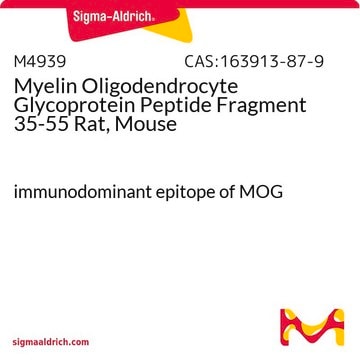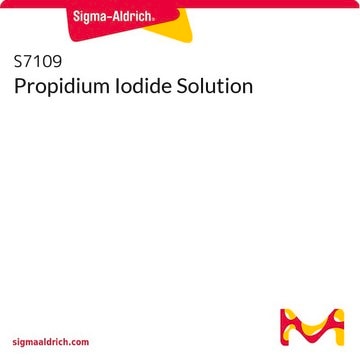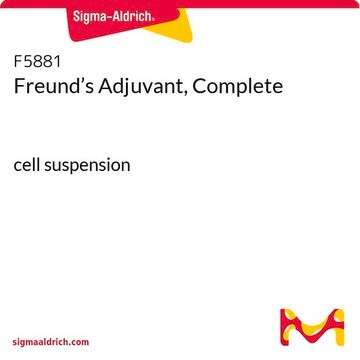The product has not been validated for immunofluorescence assay in our laboratory to establish a reference protocol. In cases where propidium iodide binds to both DNA and RNA, the use of RNase is common to differentiate DNA staining from undesired RNA staining. For an application protocol, one may refer to a citation of this product in an immunofluorescence assay that utilizes RNase to visualize DNA-specific staining. The citation is as follows: J Cancer. 2020 Mar 5;11(11):3274-3287. The article discusses the dual role of BI 2536, a small-molecule inhibitor targeting PLK1, in inducing apoptosis and attenuating autophagy in neuroblastoma cells. The PMID for the article is 32231733.
P4170
Iodure de propidium
≥94.0% (HPLC)
Synonyme(s) :
Diiodure de 3,8-diamino-5-[3-(diéthylméthylammonio)propyl]-6-phénylphénanthridinium diiodide
Sélectionner une taille de conditionnement
58,10 €
Sélectionner une taille de conditionnement
About This Item
58,10 €
Produits recommandés
Niveau de qualité
Pureté
≥94.0% (HPLC)
Forme
powder
Pf
220-225 °C (dec.) (lit.)
Température de stockage
2-8°C
Chaîne SMILES
[I-].[I-].CC[N+](C)(CC)CCC[n+]1c(-c2ccccc2)c3cc(N)ccc3c4ccc(N)cc14
InChI
1S/C27H33N4.2HI/c1-4-31(3,5-2)17-9-16-30-26-19-22(29)13-15-24(26)23-14-12-21(28)18-25(23)27(30)20-10-7-6-8-11-20;;/h6-8,10-15,18-19,29H,4-5,9,16-17,28H2,1-3H3;2*1H/q+1;;/p-1
Clé InChI
XJMOSONTPMZWPB-UHFFFAOYSA-M
Vous recherchez des produits similaires ? Visite Guide de comparaison des produits
Description générale
Application
Caractéristiques et avantages
Mention d'avertissement
Warning
Mentions de danger
Conseils de prudence
Classification des risques
Muta. 2
Code de la classe de stockage
11 - Combustible Solids
Classe de danger pour l'eau (WGK)
WGK 3
Point d'éclair (°F)
Not applicable
Point d'éclair (°C)
Not applicable
Équipement de protection individuelle
dust mask type N95 (US), Eyeshields, Gloves
Certificats d'analyse (COA)
Recherchez un Certificats d'analyse (COA) en saisissant le numéro de lot du produit. Les numéros de lot figurent sur l'étiquette du produit après les mots "Lot" ou "Batch".
Déjà en possession de ce produit ?
Retrouvez la documentation relative aux produits que vous avez récemment achetés dans la Bibliothèque de documents.
Les clients ont également consulté
Articles
Cell cycle phases (G1, S, G2, M) regulate cell growth, DNA replication, and division in proliferating cells.
Apoptosis regulation involves multiple pathways and molecules for cellular homeostasis.
Contenu apparenté
Nancy-520 for DNA Detection and Quantitation
-
Is it necessary to carry out an RNase treatment before staining with propidium iodide in my immunofluorescence assay on insect tissue fixed in 4% paraformaldehyde? Additionally, is there the complete staining protocol for propidium iodide in immunofluorescence using a confocal microscope?
1 answer-
Helpful?
-
-
What is the procedure for dissolving this product?
1 answer-
Propidium iodide is soluble in water at a concentration of 1 mg/mL.
Helpful?
-
-
Is this reagent suited for viability assays at FACS?
1 answer-
While this product is not tested for any specific application, propidium iodide is commonly used in cell-based assays such as FACS. Please see the link below to review publications detailing the use of this item in flow cytometry:
https://scholar.google.com/scholar?hl=en&as_sdt=0%2C22&q=%22p4170%22+flow+cytometry&btnG=Helpful?
-
-
What is the method to dissolve this product?
1 answer-
Propidium iodide can be dissolved in water at a concentration of 1 mg/mL. Please see the sample Certificate of Analysis for solubility information: https://www.sigmaaldrich.com/certificates/sapfs/PROD/sap/certificate_pdfs/COFA/Q14/P4170-BULKWXBF1544V.pdf
Helpful?
-
Active Filters
Notre équipe de scientifiques dispose d'une expérience dans tous les secteurs de la recherche, notamment en sciences de la vie, science des matériaux, synthèse chimique, chromatographie, analyse et dans de nombreux autres domaines..
Contacter notre Service technique












